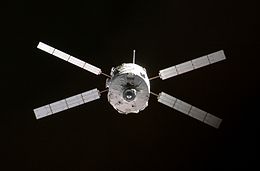Jules Verne ATV

Jules Verne on its approach to the International Space Station.
|
|
| Mission type | ISS resupply |
|---|---|
| Operator | European Space Agency |
| COSPAR ID | 2008-008A |
| SATCAT № | 32686 |
| Mission duration | 7 months |
| Spacecraft properties | |
| Spacecraft type | ATV |
| Manufacturer |
EADS Astrium Thales Alenia Space |
| Launch mass | 19,360 kilograms (42,680 lb) |
| Start of mission | |
| Launch date | 9 March 2008, 04:03 UTC |
| Rocket | Ariane 5ES |
| Launch site | Kourou ELA-3 |
| Contractor | Arianespace |
| End of mission | |
| Disposal | Deorbited |
| Decay date | 29 September 2008, 13:31 UTC |
| Orbital parameters | |
| Reference system | Geocentric |
| Regime | Low Earth |
| Perigee | 331 kilometres (179 nmi) |
| Apogee | 339 kilometres (183 nmi) |
| Inclination | 51.6 degrees |
| Period | 91.34 minutes |
| Docking with ISS | |
| Docking port | Zvezda Aft |
| Docking date | 3 April 2008, 14:45 UTC |
| Undocking date | 5 September 2008, 21:29 UTC |
| Time docked | 5 months |
| Cargo | |
| Mass | 2,297 kilograms (5,064 lb) |
| Pressurised | 1,150 kilograms (2,540 lb) |
| Fuel | 856 kilograms (1,887 lb) |
| Gaseous | 21 kilograms (46 lb) |
| Water | 270 kilograms (600 lb) |
The Jules Verne ATV, or Automated Transfer Vehicle 001 (ATV-001), was an unmanned cargo resupply spacecraft launched by the European Space Agency (ESA). The ATV was named after the 19th-century French science-fiction author Jules Verne. It was launched on 9 March 2008 on a mission to supply the International Space Station (ISS) with propellant, water, air, and dry cargo. Jules Verne was the first of five ATVs to be launched.
Because it was the first ATV to be launched, Jules Verne underwent three weeks of orbital testing before beginning its final rendezvous with the ISS. The spacecraft docked to the ISS on 3 April 2008 to deliver its cargo. On 25 April 2008, Jules Verne used its thrusters to reboost the station into a higher orbit. After spending just over five months docked at the station, Jules Verne undocked on 5 September 2008 and made a destructive re-entry over the Pacific Ocean on 29 September.
The first ATV was officially named Jules Verne on 9 April 2002; it was originally planned to be one of seven ATVs, and to launch in 2007. By the end of January 2003, most of its components had been assembled. These components were built by several different aerospace companies; the docking and refuelling systems were produced by RSC Energia in Russia, the pressurised section was assembled by Alenia Spazio in Turin, Italy, and the propulsion system was constructed by EADS Astrium in Bremen, Germany. The propulsion system was integrated with the pressurised compartment in Bremen, before the spacecraft was moved to the European Space Research and Technology Centre (ESTEC) in Noordwijk, the Netherlands, for testing. It arrived at ESTEC on 15 July 2004.
...
Wikipedia
